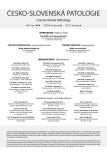Dvě pitvy, ve kterých předchozí operace usnadnila ztotožnění posmrtně dekomponovaných těl
Authors:
Shogo Kasuda; Risa Kudo; Katsuya Yuui; Hiroko Imai; Masatoshi Nakata; Katsuhiko Hatake
Authors‘ workplace:
Department of Legal Medicine, Nara Medical University, Nara, Japan
Published in:
Soud Lék., 61, 2016, No. 4, p. 42-43
Category:
Original Article
Overview
Identifikace posmrtně dekomponovaného těla je často obtížné. V práci je uveden popis dvou případů, ve kterých usnadnil identifikaci nález chirurgických implantátů.
Případ č. 1:
V bytě bylo nalezeno lidské tělo ve značném stadiu hnilobného rozkladu. Předpokládalo se, že může jít o staršího muže, který zde žil sám. Během soudní pitvy byl nalezen v aortě a obou společných ilických tepnách stav po rekonstrukci pomocí syntetických štěpů.
Případ č. 2:
Pokročile dekomponované lidské tělo bylo nalezeno ve vaně. Předpokládalo se, že zemřelý byl starší muž, žijící sám v domě. Soudní pitva objevila kovové šrouby, implantované oboustranně v hlavicích stehenních kostí.
V obou těchto případech bylo tedy možné úspěšně přispět k identifikaci neznámých osob na základě záznamů o předchozích chirurgických zákrocích. Nález zemřelých v pokročilém stadium dekompozice je v Japonsku v důsledku rostoucího počtu osaměle žijících starších lidí stále častější. V těchto případech je obtížné používat analýzu DNA, otisky prstů a metody forenzní stomatologie. Snadněji než zubní kartu je možné získat všeobecné lékařské záznamy, a tyto záznamy poskytují značné množství antemortem informací. Chirurgicky implantované materiály jsou trvanlivé a dlouho vydrží. Proto mohou být užitečným nástrojem pro identifikaci neznámých osob.
Klíčová slova:
soudní pitva – identifikace – implantované zdravotnické materiály – senioři – smrt beze svědků.
The positive identification of unidentified corpses is a routine but important task for forensic pathologists, which typically involves DNA tests, finger prints, and dental findings (1-3). However, we often experience cases in which these methods cannot be used. Therefore, we report two cases of decomposed corpses in which positive identification was facilitated by medical materials that were implanted during previous surgical treatments. These cases are good examples of how autopsy is useful for both determining the cause of death and providing a personal identification.
CASE REPORT
Case 1
Highly decomposed remains were found in an apartment. The deceased was assumed to be a man in his sixties who lived alone in the room. Therefore, a medico-legal autopsy was performed to clarify the cause of death and confirm his identity. We diagnosed the cause of death as chronic ischemic heart disease, due to complete coronary occlusion that was found during the autopsy. We also observed that the aorta and common iliac arteries had been rebuilt using a synthetic graft (Figure 1). The inhabitant of the room had undergone implantation of a blood vessel prosthesis for abdominal aorta aneurysm, which allowed us to make a positive identification, based on his medical records.

Case 2
Highly decomposed remains were found in a bathtub. The deceased was assumed to be a man in his eighties who lived alone in the house. We performed a medico-legal autopsy and observed complete coronary occlusion; therefore, we diagnosed the cause of death as chronic ischemic heart disease. We also observed that metallic screws had been implanted in the bilateral femoral heads (Figure 2). The inhabitant of the house had a history of bilateral femoral bone fractures and had been treated using compression hip screws, which allowed us to make a positive identification, based on his medical records.

DISCUSSION
In these cases, two elderly deceased men who lived alone were found in a highly decomposed state. In Japan, it is not uncommon for single elderly people to have no relatives, which can significantly delay the discovery than an individual has died. As the corpses were highly decomposed, it was impossible to obtain fingerprints, and DNA testing is only useful if there are DNA samples available from the deceased individual’s family members. Moreover, both deceased individuals did not have a dental history and no dental charts were available. However, medical records are easier to obtain, compared to dental charts, and provide a significant amount of antemortem information regarding the victim. As surgically placed medical materials and devices are durable and last for a long time, they are useful for personal identification, and several previous reports have described the usefulness of medical materials and devices in the identification process (4,5). Unfortunately, lonely death due to social isolation has become an increasingly common phenomenon in Japan. Therefore, given the recent advances in medical technology, implanted medical materials and devices may be a useful tool for personal identification in the near future.
CONFLICT OF INTEREST
The authors declare that there is no conflict of interest regarding the publication of this paper.
Correspondence address:
Shogo Kasuda, MD, PhD
Department of Legal Medicine, Nara Medical University
840 Shijocho, Kashihara, Nara 634-8521,
Japan
phone: +81-744-29-8843
fax: +81-744-29-1116
e-mail: skasuda@naramed-u.ac.jp
Sources
1. Benecke M. DNA typing in forensic medicine and in criminal investigations: a current survey. Naturwissenschaften 1997; 84(5): 181-188.
2. Holobinko A. Forensic human identification in the United States and Canada: a review of the law, admissible techniques, and the legal implications of their application in forensic cases. Forensic Sci Int 2012; 222(1-3): 394.e1-13.
3. Caplan RM. How fingerprints came into use for personal identification. J Am Acad Dermatol 1990; 23(1): 109-114.
4. Issacs TW, Margolius KA, Chester GH. Postmortem identification by means of a recovered intraocular lens. Am J Forensic Med Pathol 1997; 18(4): 404-405.
5. Kinoshita H, Motomura H, Kasuda S, et al. Positive identification facilitated by implanted metallic plate and screws. Soud Lek 2009; 54(2): 16.
Labels
Anatomical pathology Forensic medical examiner ToxicologyArticle was published in
Forensic Medicine

2016 Issue 4
Most read in this issue
- Vyšetrovanie alveolárneho vzduchu post mortem v súdnolekárskej praxi
- Dvě pitvy, ve kterých předchozí operace usnadnila ztotožnění posmrtně dekomponovaných těl
